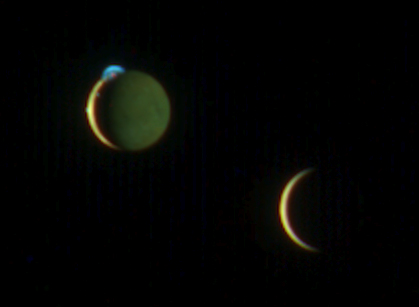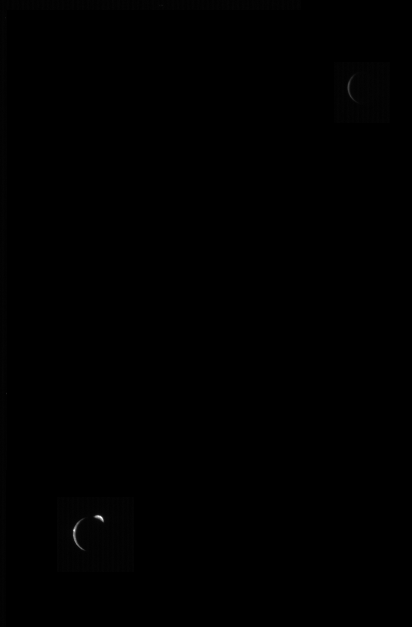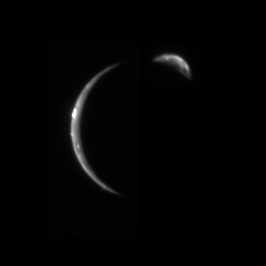Emily Lakdawalla • Jan 24, 2008
I spy Callisto
I've been noodling around a bit more with the data, recently released to the Planetary Data System, from New Horizons' Multispectral Visual Imaging Camera (MVIC). Unlike New Horizons' higher-resolution but monochrome Long-range Reconnaissance Imager (LORRI), MVIC couldn't be used during much of the Jupiter flyby because it was too sensitive; the relatively bright light levels at Jupiter's distance from the Sun overwhelmed MVIC's detectors. The prettiest MVIC images were taken late in the flyby, with the Sun lighting Jupiter's moons as crescents. My favorite image to date was this one, which I wrote about in May, showing Io and Europa floating together in space.

NASA / JHUAPL / SwRI
Io and Europa
Io and Europa shone as jewel-toned crescents to the MVIC imaging spectrometer on New Horizons as the spacecraft sped away from Jupiter at 10:34 UT on March 2, 2007. Europa appears to be the larger of the two, but that's an optical illusion because of their different distances from the spacecraft: larger Io (3,630 kilometers in diameter) is 4.6 million kilometers from New Horizons, while smaller Europa (3,122 kilometers in diameter) is closer at 3.8 million kilometers away. When this image was taken, Io was on the far side of Jupiter from New Horizons, while Europa was closer to Jupiter than New Horizons. Being on the far side of Jupiter, Io's night side is lit by sunlight reflected off of Jupiter's cloud tops. Europa's night side is not, because the side of Europa that is receiving reflected light from Jupiter is the side that is facing away from New Horizons.
NASA / JHUAPL / SwRI
Io and Callisto from New Horizons
In the last image taken of Io by New Horizons' Multispectral Visual Imaging Camera (MVIC), on March 3, 2007 at 06:06 UTC, the plumes of Tvashtar and Prometheus are lit brightly by the Sun, lying nearly behind the moon. Also visible in the image is the much darker crescent of Callisto. Callisto orbits at more than four times the distance of Jupiter than Io does.I keep on finding more treasures as I dig through this data set. It's not a large one as data sets go, just about a thousand images from LORRI and about a hundred from MVIC, but each one is a treat. I'm working on figuring out how to post the data set in a format that will make it easier for more of you to find your own buried treasure.
Support our core enterprises
Your support powers our mission to explore worlds, find life, and defend Earth. You make all the difference when you make a gift. Give today!
Donate

 Explore Worlds
Explore Worlds Find Life
Find Life Defend Earth
Defend Earth


